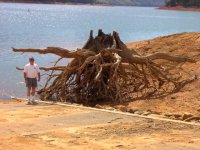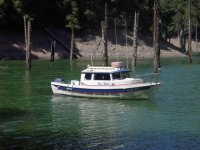Sea Wolf
New member
- Joined
- Nov 1, 2003
- Messages
- 8,650
- Reaction score
- 0
- C Dory Year
- 1987
- C Dory Model
- 22 Cruiser
- Hull Identification Number
- DOR22286A787
- Vessel Name
- Sea Wolf
An Update!
Yep, we got 'er back! Went up to Stein Creek (15 miles from Bridge Bay Marina) on Sunday to check out if we could still get the 24' pontoon boat (better working platform) back into the tree trunk infested, narrow cove.
The water was still 10 feet deep over the anchor, but we found it with our underwater camera (+ a ton of curious bass) and using some markers of string tied around the tree trunks back when the water was 17 feet deeper. We first got ahold of the underwater tree with a grappliing hook I had made.
We then anchored over it with a 18 lb mushroom anchor (less prone to getting tangled up), and my son then dove on it several times, bringing up the end of the 100 ft chain by pulling himself and the chain up on the new anchor rope.
After retrieving most of the 75 lbs of chain, we still needed to pry the anchor off of a 3 -4 inch diameter branch of a submerged tree.
I tied a line to a 4-foot crowbar and then taped it up with duct tape (The Sailor's Universal Solution to All of Mankind's Unfortunate Engineering Failures) for safe keeping so the knots wouldn't slip off.
I then lowered the crowbar down the anchor chain with my son (likely soon to be heir to my vast fortune) to pry loose the big hook .
Success on the first attempt!
Once aboard, we then had to unhook the mushroom anchor and another grappling hook that we had used to get ahold of the tree. Amazingly, the trees have been submerged since 1948 (58 years!), and are still pretty strong!
So we got 'er back, with little damage except for some algae growth that was fairly easily washed off.
Later, when the water has gone down another 12-15 feet, I'll go back in there to find the cap to my windlass that broke off during the wrestling match between my 90 hp Yamaha and the 58 year old sunken tree. Should be able to find it with a rake once the bottom is dry.
Joe.
Yep, we got 'er back! Went up to Stein Creek (15 miles from Bridge Bay Marina) on Sunday to check out if we could still get the 24' pontoon boat (better working platform) back into the tree trunk infested, narrow cove.
The water was still 10 feet deep over the anchor, but we found it with our underwater camera (+ a ton of curious bass) and using some markers of string tied around the tree trunks back when the water was 17 feet deeper. We first got ahold of the underwater tree with a grappliing hook I had made.
We then anchored over it with a 18 lb mushroom anchor (less prone to getting tangled up), and my son then dove on it several times, bringing up the end of the 100 ft chain by pulling himself and the chain up on the new anchor rope.
After retrieving most of the 75 lbs of chain, we still needed to pry the anchor off of a 3 -4 inch diameter branch of a submerged tree.
I tied a line to a 4-foot crowbar and then taped it up with duct tape (The Sailor's Universal Solution to All of Mankind's Unfortunate Engineering Failures) for safe keeping so the knots wouldn't slip off.
I then lowered the crowbar down the anchor chain with my son (likely soon to be heir to my vast fortune) to pry loose the big hook .
Success on the first attempt!
Once aboard, we then had to unhook the mushroom anchor and another grappling hook that we had used to get ahold of the tree. Amazingly, the trees have been submerged since 1948 (58 years!), and are still pretty strong!
So we got 'er back, with little damage except for some algae growth that was fairly easily washed off.
Later, when the water has gone down another 12-15 feet, I'll go back in there to find the cap to my windlass that broke off during the wrestling match between my 90 hp Yamaha and the 58 year old sunken tree. Should be able to find it with a rake once the bottom is dry.
Joe.


